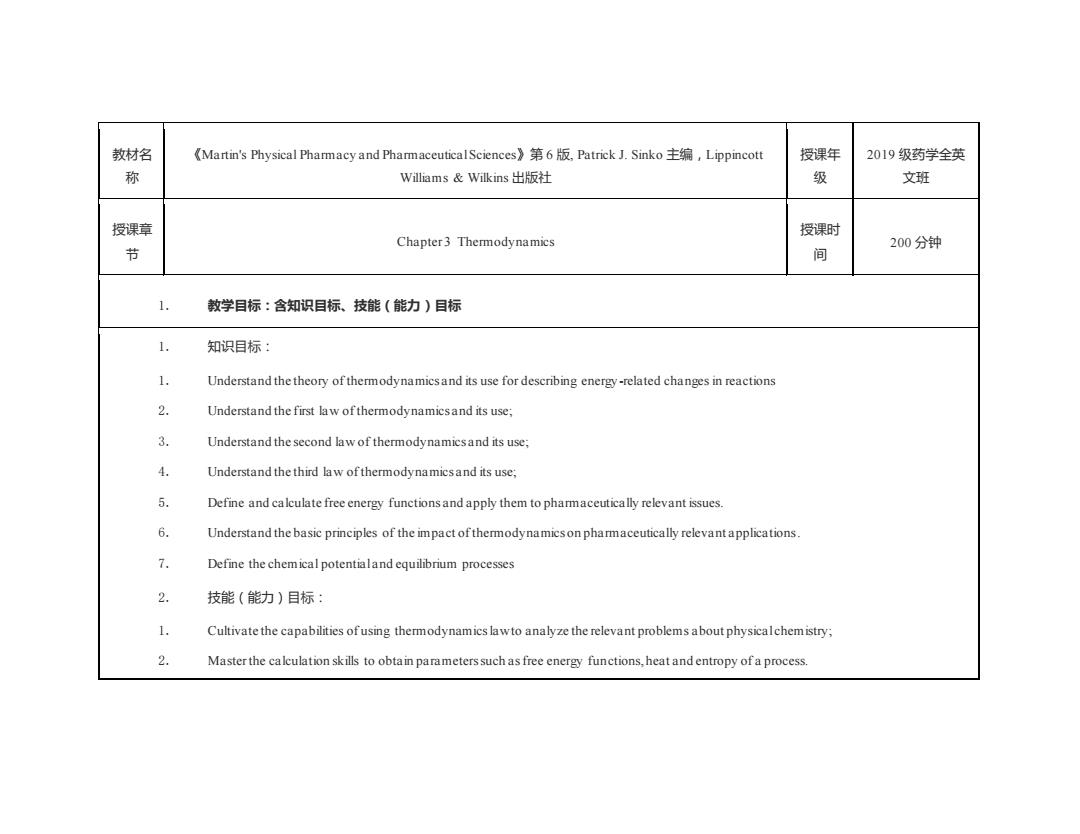
教材名 《Martin's Physical Pharmacy and PharmaceuticalSciences》第6版,Patrick J.Sinko主编,Lippincott 授课年 2019级药学全英 称 Williams&Wilkins出版社 级 文班 授课章 授课时 Chapter3 Thermodynamics 节 200分钟 间 1. 教学目标:含知识目标、技能(能力)目标 1. 知识目标: 1. Understand the theory of thermodynamicsand its use for describing energy-related changes in reactions 2. Understand the first law ofthermodynamicsand its use; 3. Understand the second law of thermodynamicsand its use; 4. Understand the third law ofthermodynamicsand its use; 5. Define and calculate free energy functions and apply them to pharmaceutically relevant issues. 6. Understand the basic principles of the impact ofthermodynamicson pharmaceutically relevant applications. Define the chemical potentialand equilibrium processes 2. 技能(能力)目标: 1. Cultivate the capabilities of using thermodynamics lawto analyze the relevant problems about physicalchemistry; 2. Master the calculation skills to obtain parameters such as free energy functions,heat and entropy of a process
教材名 称 《Martin's Physical Pharmacy and Pharmaceutical Sciences》第 6 版, Patrick J. Sinko 主编,Lippincott Williams & Wilkins 出版社 授课年 级 2019 级药学全英 文班 授课章 节 Chapter 3 Thermodynamics 授课时 间 200 分钟 1. 教学目标:含知识目标、技能(能力)目标 1. 知识目标: 1. Understand the theory of thermodynamics and its use for describing energy-related changes in reactions 2. Understand the first law of thermodynamics and its use; 3. Understand the second law of thermodynamics and its use; 4. Understand the third law of thermodynamics and its use; 5. Define and calculate free energy functions and apply them to pharmaceutically relevant issues. 6. Understand the basic principles of the impact of thermodynamics on pharmaceutically relevant applications. 7. Define the chemical potential and equilibrium processes 2. 技能(能力)目标: 1. Cultivate the capabilities of using thermodynamics law to analyze the relevant problems about physical chemistry; 2. Master the calculation skills to obtain parameters such as free energy functions, heat and entropy of a process
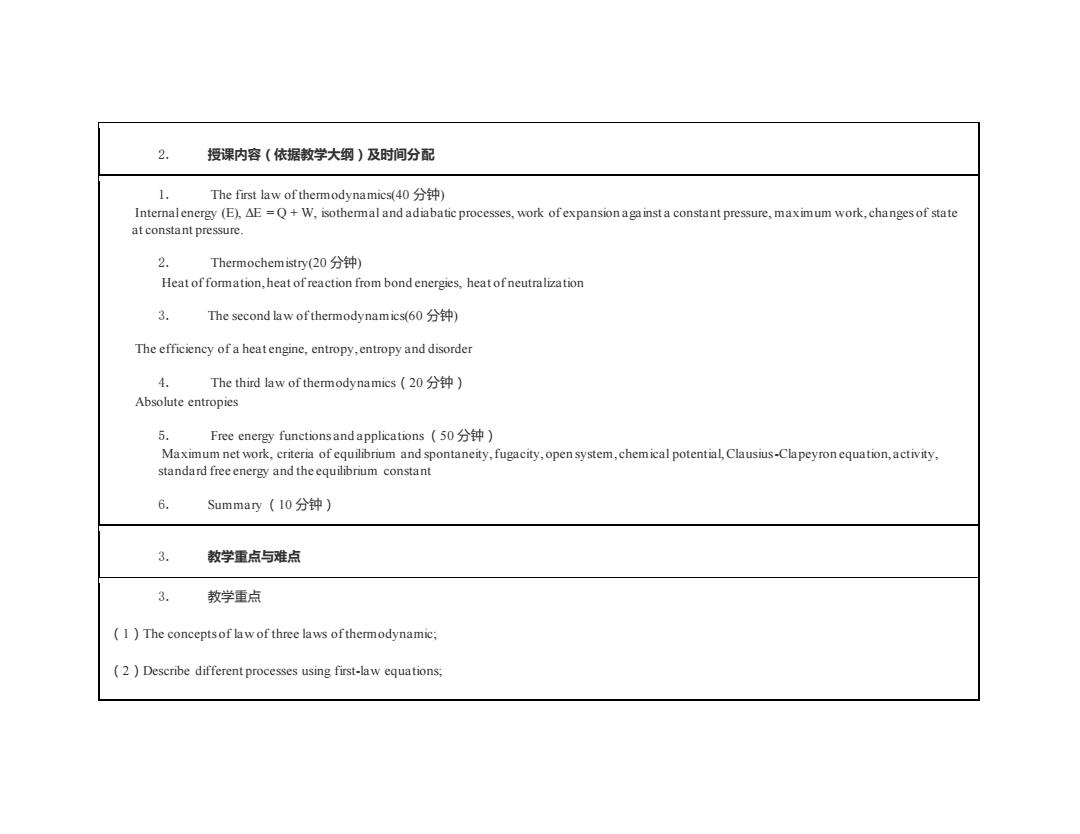
2. 授课内容(依据教学大纲)及时间分配 1. The first law of thermodynamics(40分钟) Internalenergy(E),AE =Q+W,isothermal and adiabatic processes,work ofexpansionagainst a constant pressure,maximum work,changes of state at constant pressure. 2. Thermochemistry(20分钟) Heat of formation,heat of reaction from bond energies,heat ofneutralization 3. The second law ofthermodynamics(60分钟) The efficiency of a heatengine,entropy,entropy and disorder 4. The third law of thermodynamics(20分钟) Absolute entropies 5. Free energy functionsand applications (50) Maximum net work,criteria of equilibrium and spontaneity,fugacity,open system,chemical potential,Clausius-Clapeyronequation,activity, standard free energy and theequilibrium constant 6. Summary(l0分钟) 3. 教学重点与难点 3. 教学重点 (1 )The conceptsof law of three laws ofthermodynamic; (2 )Describe different processes using first-law equations;
2. 授课内容(依据教学大纲)及时间分配 1. The first law of thermodynamics(40 分钟) Internal energy (E), ΔE = Q + W, isothermal and adiabatic processes, work of expansion against a constant pressure, maximum work, changes of state at constant pressure. 2. Thermochemistry(20 分钟) Heat of formation, heat of reaction from bond energies, heat of neutralization 3. The second law of thermodynamics(60 分钟) The efficiency of a heat engine, entropy, entropy and disorder 4. The third law of thermodynamics(20 分钟) Absolute entropies 5. Free energy functions and applications (50 分钟) Maximum net work, criteria of equilibrium and spontaneity, fugacity, open system, chemical potential, Clausius-Clapeyron equation, activity, standard free energy and the equilibrium constant 6. Summary (10 分钟) 3. 教学重点与难点 3. 教学重点 (1)The concepts of law of three laws of thermodynamic; (2)Describe different processes using first-law equations;
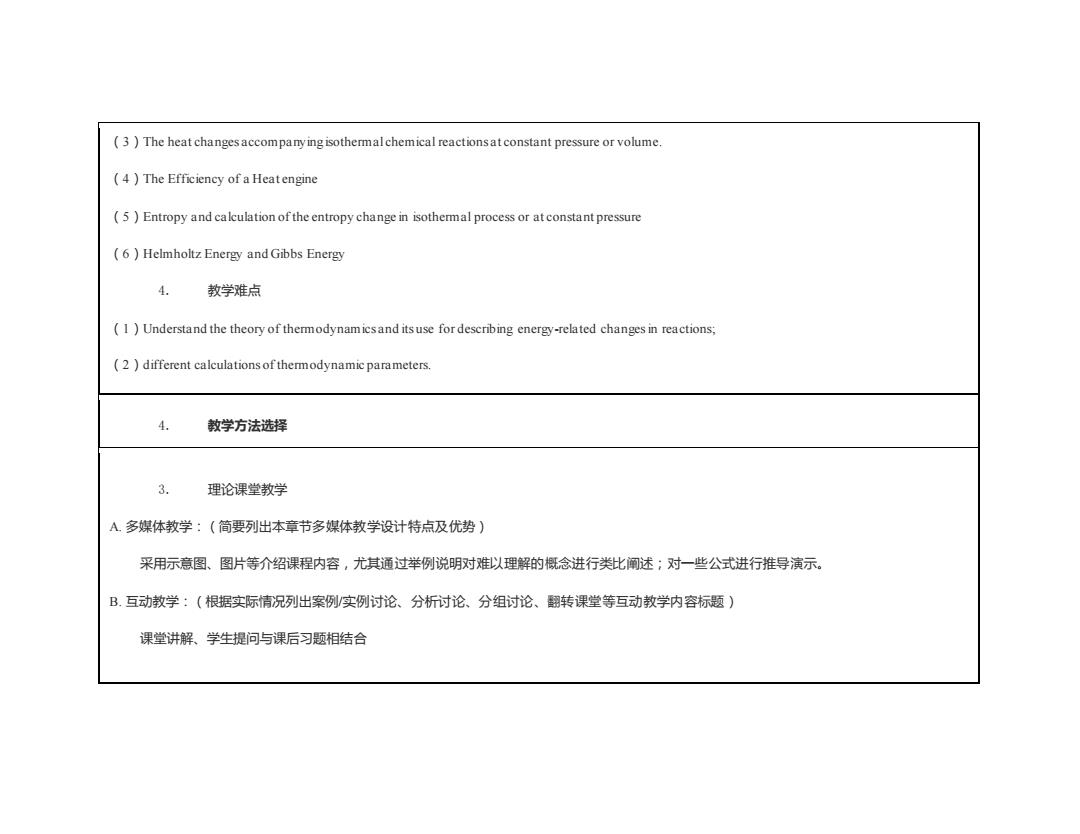
(3)The heat changesaccompanying isothermalchemical reactionsatconstant pressure or volume. (4 )The Efficiency of a Heatengine (5 )Entropy and calculation of the entropy change in isothermal process or at constant pressure (6)Helmholtz Energy and Gibbs Energy 4. 教学难点 (I )Understand the theory of thermodynamicsand itsuse for describing energy-related changes in reactions, (2 )different calculations ofthermodynamic parameters. 4. 教学方法选择 3. 理论课堂教学 A多媒体教学:(简要列出本章节多媒体教学设计特点及优势) 采用示意图、图片等介绍课程内容,尤其通过举例说明对难以理解的概念进行类比阐述;对一些公式进行推导演示。 B.互动教学:(根据实际情况列出案例/实例讨论、分析讨论、分组讨论、翻转课堂等互动教学内容标题) 课堂讲解、学生提问与课后习题相结合
(3)The heat changes accompanying isothermal chemical reactions at constant pressure or volume. (4)The Efficiency of a Heat engine (5)Entropy and calculation of the entropy change in isothermal process or at constant pressure (6)Helmholtz Energy and Gibbs Energy 4. 教学难点 (1)Understand the theory of thermodynamics and its use for describing energy-related changes in reactions; (2)different calculations of thermodynamic parameters. 4. 教学方法选择 3. 理论课堂教学 A. 多媒体教学:(简要列出本章节多媒体教学设计特点及优势) 采用示意图、图片等介绍课程内容,尤其通过举例说明对难以理解的概念进行类比阐述;对一些公式进行推导演示。 B. 互动教学:(根据实际情况列出案例/实例讨论、分析讨论、分组讨论、翻转课堂等互动教学内容标题) 课堂讲解、学生提问与课后习题相结合
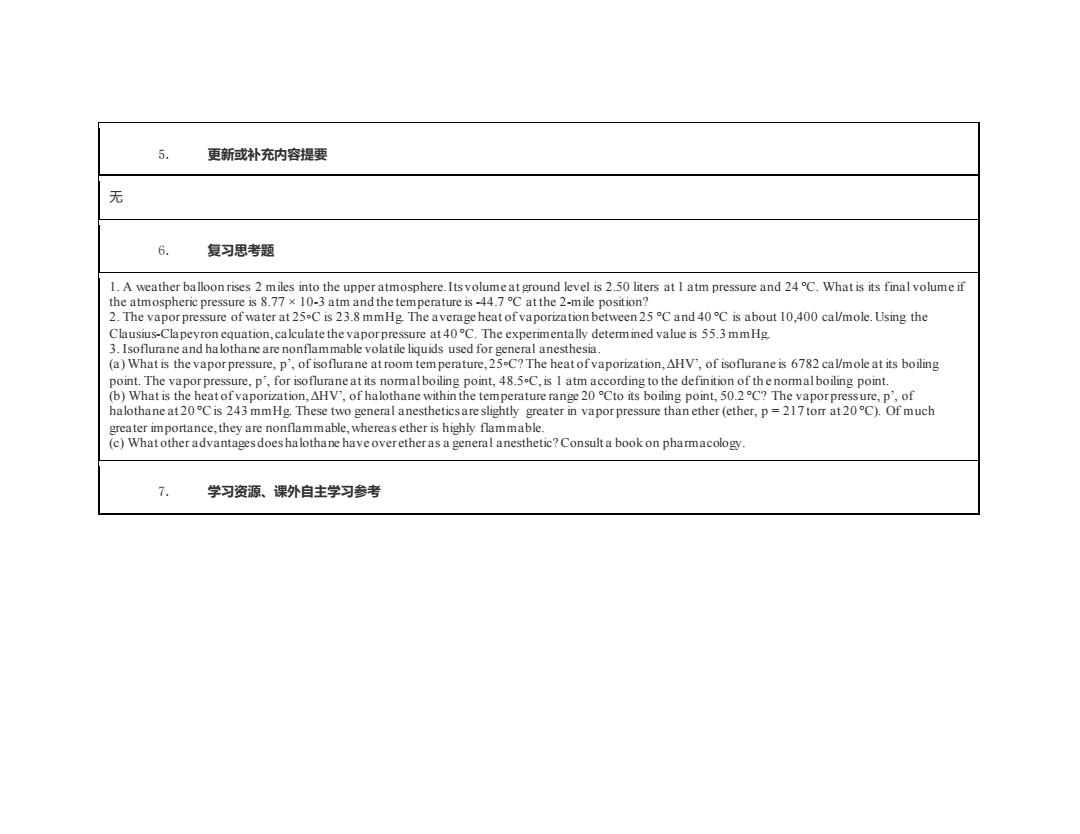
5. 更新或补充内容提要 无 6. 复习思考题 1.A weather balloon rises 2 miles into the upper atmosphere.Its volumeat ground level is 2.50 liters at I atm pressure and 24C.What is its final volume if the atmospheric pressure is 8.77 x 10-3 atm and the temperature is-44.7C at the 2-mile position? 2.The vapor pressure of water at 25C is 23.8 mmHg The average heat of vaporization between 25C and 40C is about 10,400 cal/mole.Using the Clausius-Clapeyron equation,calculate the vapor pressure at40C.The experimentally determined value is 55.3 mmHg 3.Isoflurane and halothane are nonflammable volatile liquids used for general anesthesia. (a)What is the vapor pressure,p',of isoflurane atroom temperature,25C?The heat ofvaporization,AHV,of isoflurane is 6782 cal/mole at its boiling point.The vapor pressure,p',for isoflurane at its nommalboiling point,48.5C,is I atm according to the definition of thenormalboiling point. (b)What is the heat of vaporization,AHV,of halothane within the temperature range 20 Cto its boiling point,50.2C?The vaporpressure,p',of halothane at 20C is 243 mmHg These two general anestheticsare slightly greater in vapor pressure than ether(ether,p=217torr at 20C).Of much greater importance,they are nonflammable,whereas ether is highly flammable. (c)What other advantages does halothane have overether as a general anesthetic?Consult a book on pharmacology. 7. 学习资源、课外自主学习参考
5. 更新或补充内容提要 无 6. 复习思考题 1. A weather balloon rises 2 miles into the upper atmosphere. Its volume at ground level is 2.50 liters at 1 atm pressure and 24 °C. What is its final volume if the atmospheric pressure is 8.77 × 10-3 atm and the temperature is -44.7 °C at the 2-mile position? 2. The vapor pressure of water at 25◦C is 23.8 mmHg. The average heat of vaporization between 25 °C and 40 °C is about 10,400 cal/mole. Using the Clausius-Clapeyron equation, calculate the vapor pressure at 40 °C. The experimentally determined value is 55.3 mmHg. 3. Isoflurane and halothane are nonflammable volatile liquids used for general anesthesia. (a) What is the vapor pressure, p’, of isoflurane at room temperature, 25◦C? The heat of vaporization, ΔHV’, of isoflurane is 6782 cal/mole at its boiling point. The vapor pressure, p’, for isoflurane at its normal boiling point, 48.5◦C, is 1 atm according to the definition of th e normal boiling point. (b) What is the heat of vaporization, ΔHV’, of halothane within the temperature range 20 °Cto its boiling point, 50.2 °C? The vapor pressure, p’, of halothane at 20 °C is 243 mmHg. These two general anesthetics are slightly greater in vapor pressure than ether (ether, p = 217 torr at 20 °C). Of much greater importance, they are nonflammable, whereas ether is highly flammable. (c) What other advantages does halothane have over ether as a general anesthetic? Consult a book on pharmacology. 7. 学习资源、课外自主学习参考
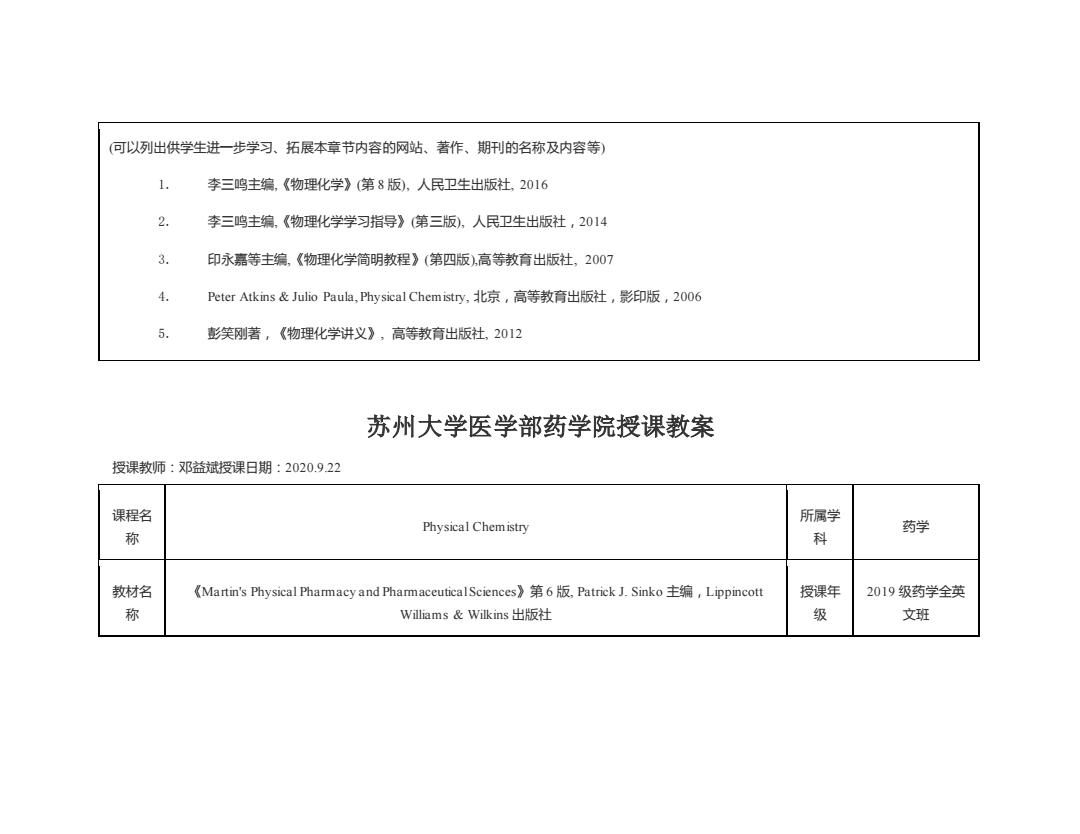
可以列出供学生进一步学习、拓展本章节内容的网站、著作、期刊的名称及内容等) 李三鸣主编,《物理化学》(第8版),人民卫生出版社,2016 2. 李三鸣主编,《物理化学学习指导》(第三版),人民卫生出版社,2014 3. 印永嘉等主编,《物理化学简明教程》(第四版),高等教育出版社,2007 4. Peter Atkins&Julio Paula,Physical Chemistry,北京,高等教育出版社,影印版,2006 5. 彭笑刚著,《物理化学讲义》,高等教育出版社,2012 苏州大学医学部药学院授课教案 授课教师:邓益斌授课日期:2020.922 课程名 所属学 称 Physical Chemistry 科 药学 教材名 《Martin's Physical Pharmacy and PharmaceuticalSciences》第6版,Patrick J.Sinko主编,Lippincott 授课年 2019级药学全英 称 Williams&Wilkins出版社 级 文班
(可以列出供学生进一步学习、拓展本章节内容的网站、著作、期刊的名称及内容等) 1. 李三鸣主编,《物理化学》(第 8 版), 人民卫生出版社, 2016 2. 李三鸣主编,《物理化学学习指导》(第三版), 人民卫生出版社,2014 3. 印永嘉等主编,《物理化学简明教程》(第四版),高等教育出版社, 2007 4. Peter Atkins & Julio Paula, Physical Chemistry, 北京,高等教育出版社,影印版,2006 5. 彭笑刚著,《物理化学讲义》, 高等教育出版社, 2012 苏州大学医学部药学院授课教案 授课教师:邓益斌授课日期:2020.9.22 课程名 称 Physical Chemistry 所属学 科 药学 教材名 称 《Martin's Physical Pharmacy and Pharmaceutical Sciences》第 6 版, Patrick J. Sinko 主编,Lippincott Williams & Wilkins 出版社 授课年 级 2019 级药学全英 文班